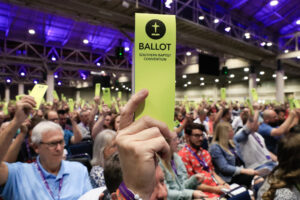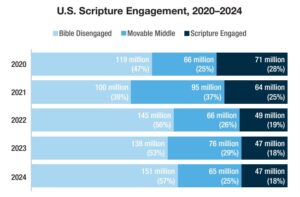
PORTLAND, Ore.(BP)??Churches that see the strongest evangelistic growth incorporate the traditional emphases of planned revivals ?? prayer, vibrant worship and a focus on the lost ?? throughout the year, according to Thomas Hammond, director of church evangelism for the North American Mission Board.
Hammond led a workshop on “Outreach: Keeping it Going” as part of NAMB’s 1997 School of Evangelism, Sept. 16?19 in Portland, Ore.
The theme of the training conference was “Reaching Out To A Changing World.” A variety of worship sessions and workshops were held, as well as practical training through two block parties and a door?to?door “saturation evangelism” opportunity. More than 50 people prayed to receive Christ as a result of the efforts.
Hammond noted when he was minister of evangelism at Hebron Baptist Church in suburban Atlanta, a church which often sees more than 500 baptisms each year, pastors would call and ask about the secrets of the church’s evangelistic success. “It was as if there was some magic pill … you could take and once you took it people were going to get saved,” he said. He told them it was as simple as prayer, and a lot of it ?? something that apparently was not what many wanted to hear.
“We’re good at planning and good at preparing, but we stink at praying,” Hammond said. “And you know why, it’s spiritual warfare. When we really get serious, struggle to pray, the spiritual attacks come.”
In too many churches, he said, concerted prayer has become almost a secondary activity reserved for Wednesday night, and then often focused on health problems in the church family.
“I’m not saying stop praying for the sick,” Hammond said. “But you can pray for the sick on and on and on and the world goes to hell.”
In revival preparation, cottage prayer meetings and ’round?the?clock prayer is common.
“It’s just amazing how God stirs in our hearts when we’re praying intentionally for souls and for revival,” Hammond said. “Then Sunday morning gets here and there’s an atmosphere of excitement. It’s electric. The place is packed, so you get up there and you’re looking at the congregation and they’re singing and smiling and saying, ‘God is here.'”
When individuals spend time on a regular basis praying with such intensity, Hammond said, it’s not long before they’ve got to go out and talk to the people they’ve been praying for about their spiritual condition.
“If you get your folks praying for revival … you won’t have time to worry about any soul?winning program. There’s going to be such a deluge of new converts that you’re going to spend most of your time discipling these young babes,” he said.
Through prayer, leaders also can be reminded evangelism is not a result of human efforts. Hammond used the illustration from the Gospel of John of Christ being the vine while we are merely the branches. “The vine brings everything needed for that branch to bear fruit,” he said. “If I’m praying in such a way that there is no blockage, I am going to be bearing the fruit. And if you’re serious about it, people are going to be saved all over your church, and as a pastor you’re not going to have a clue how.”
Worship also must be vibrant and exciting, with preaching that both emphasizes the gospel and motivates members to be evangelistic throughout the week.
“Just like all that time and energy that went into planning that revival service, that’s the same time and energy and planning that need to go into every worship service,” Hammond said. “Have your best singers sing. If you’ve only got one good singer in your church, then let that singer sing every Sunday.”
Ongoing evangelistic visitation by the laity is also essential, Hammond said. He quoted one survey that found about 47 percent of guests return the following Sunday if they are visited by the pastor or staff member within 24 hours of the service. When visited by a layperson, the percentage almost doubles. The guest sees the commitment and the dedication in a layperson volunteering his time that he may not appreciate in a paid staff member.
“The layman is there because he loves God, and they hear the layman say, ‘We want you to come back,” Hammond said. He noted many laypeople will take advantage of simple training on how to conduct a simple visit. And to be most effective, visitation should be the responsibility of the Sunday school class, so that people can relate to others of a similar age.
When a heart for evangelism does consume a church, Hammond said leaders must constantly be searching for new ways of helping extend the harvest fields after motivated members have already led many of their friends to Christ. Churches can sponsor special events, like golf tournaments or wild?game dinners that have a goal of getting non?Christians around Christians for fellowship and exposure to how Jesus Christ changes lives.
Beyond the special events, he said, everything in the church budget should be reevaluated in light of the effect it is having on seeing people led to Christ.
He noted how churches lost a prime opportunity for relational evangelism with the advent of organized softball in the 1950s and ’60s. When non?members began appearing on teams and competitive rivalries developed, churches made rules barring non?members. Those non?members later formed their own leagues, which now often play on Sundays. In Hebron’s league, the rule is that all teams must include at least one non?Christian.
“Take some time with your budget, and on each ministry see what it’s producing. If it’s not producing anything, meet with those who are serving that area and tell them there’s going to be change. We want you to be gearing your ministry not just for those who are in the boat, but for those who are outside the boat.”













